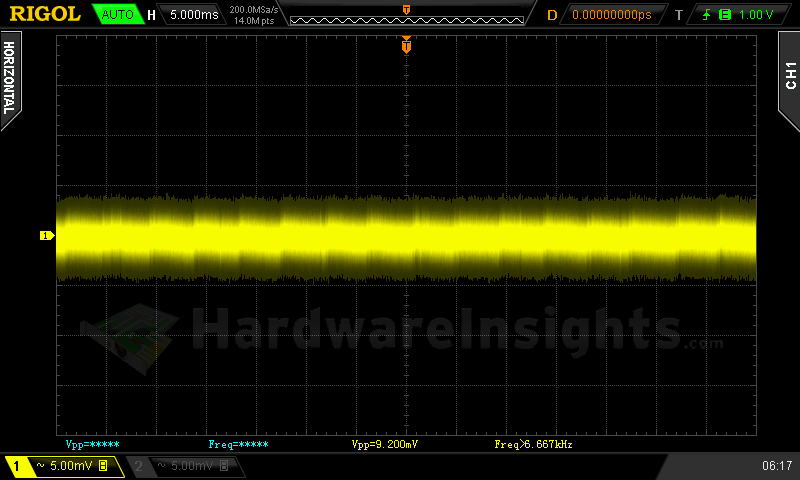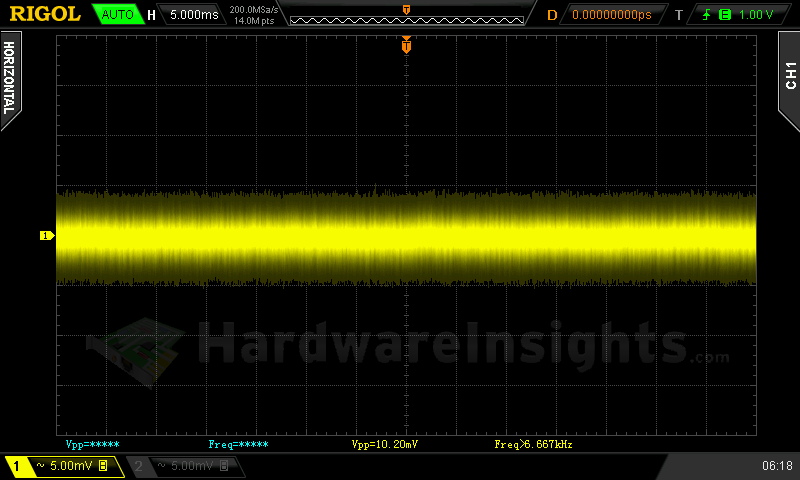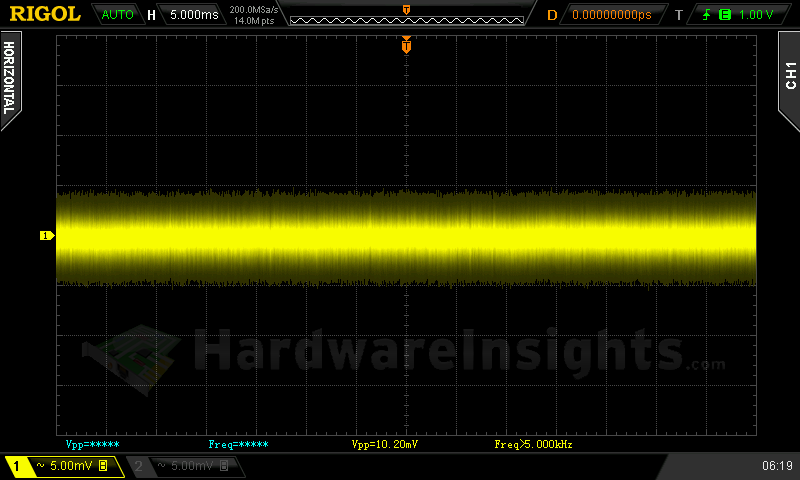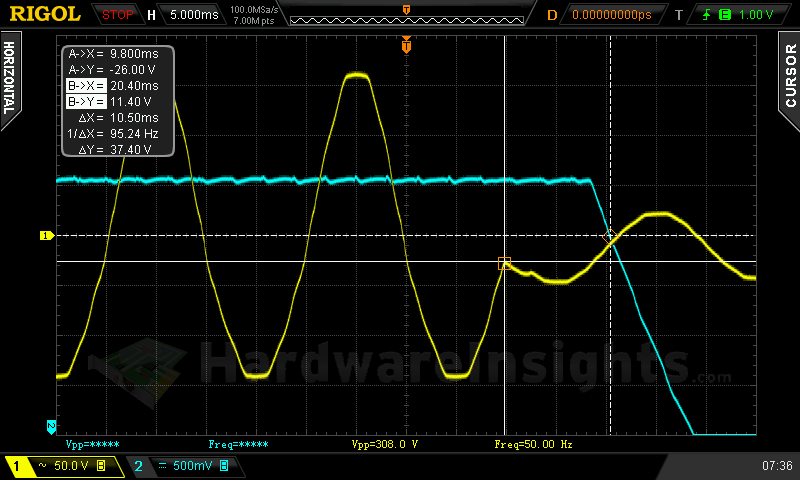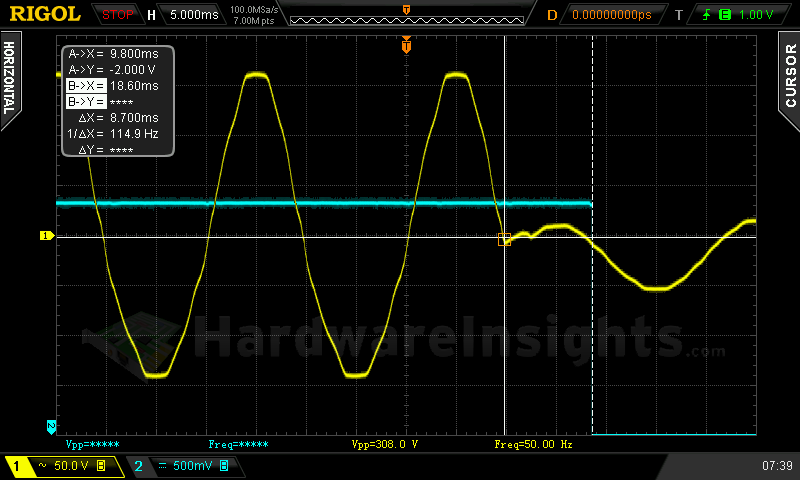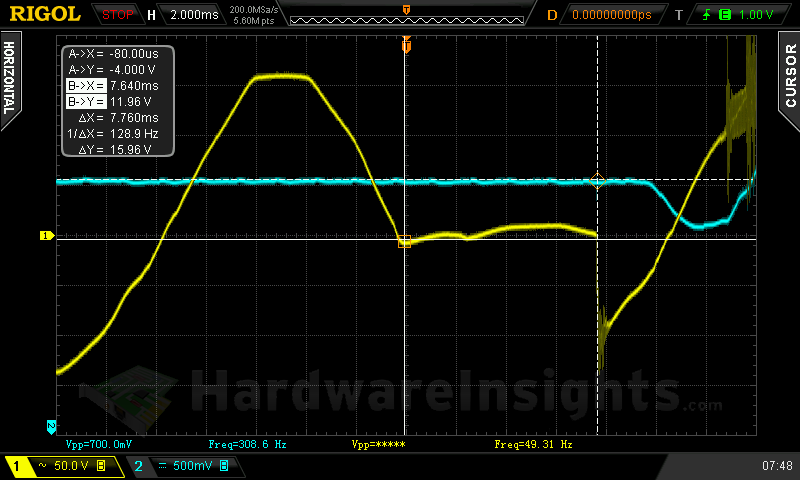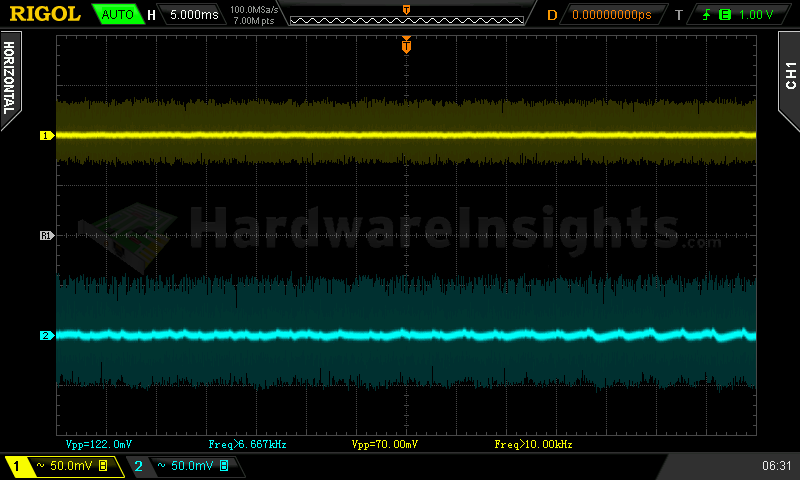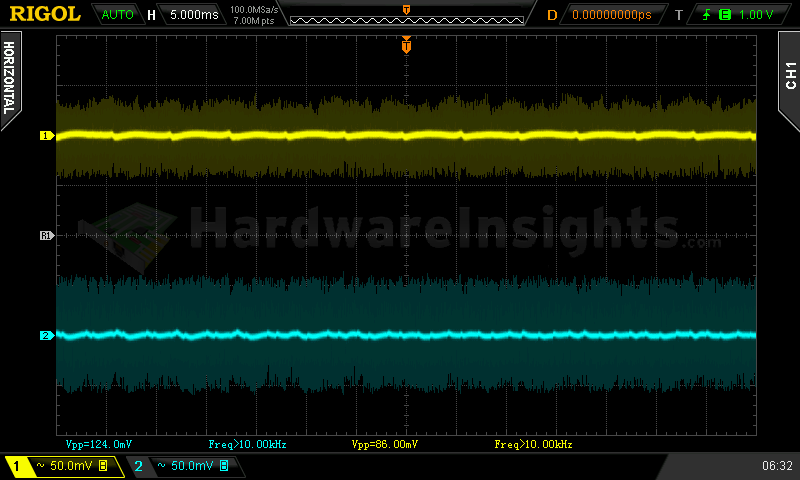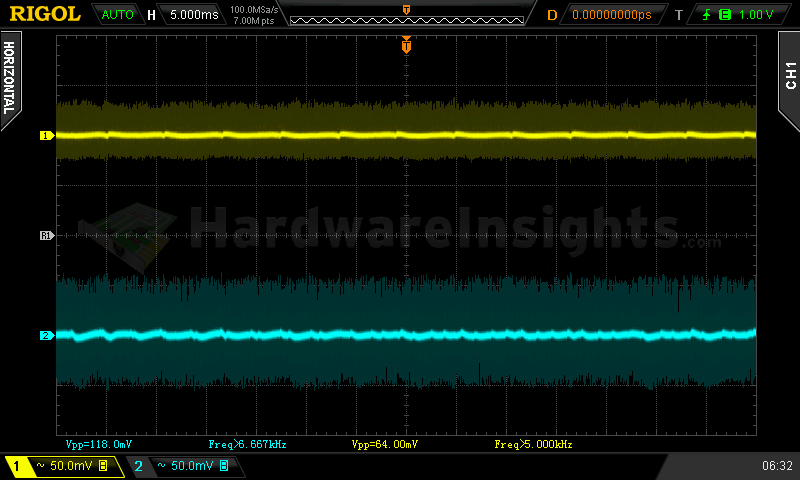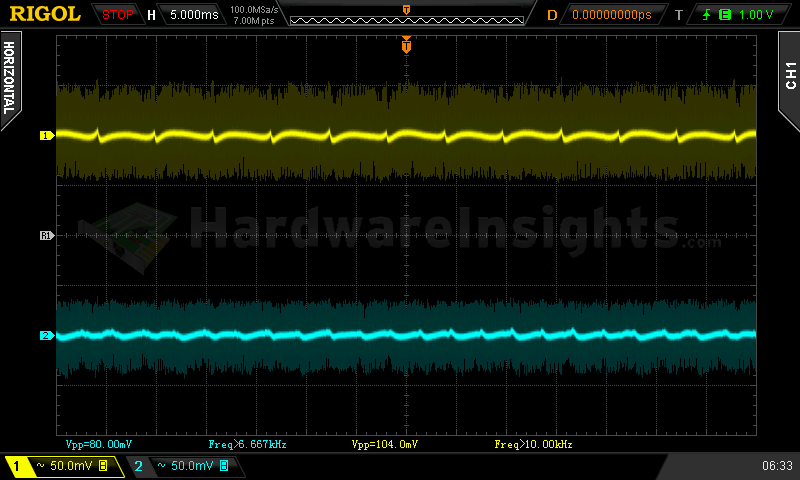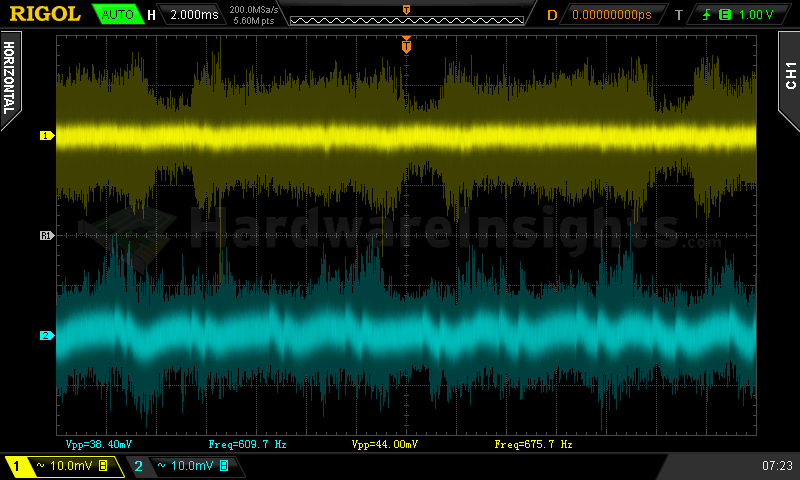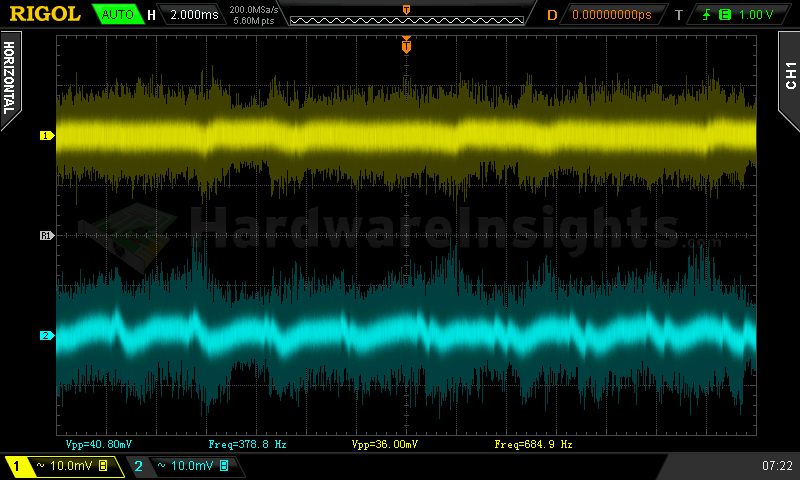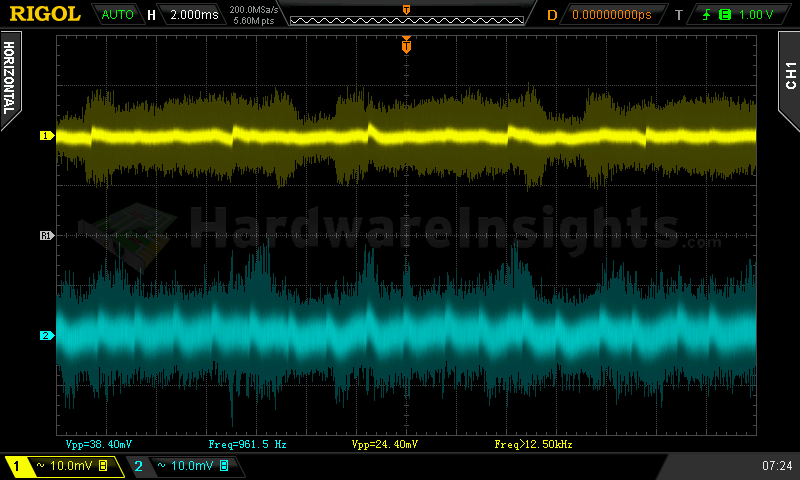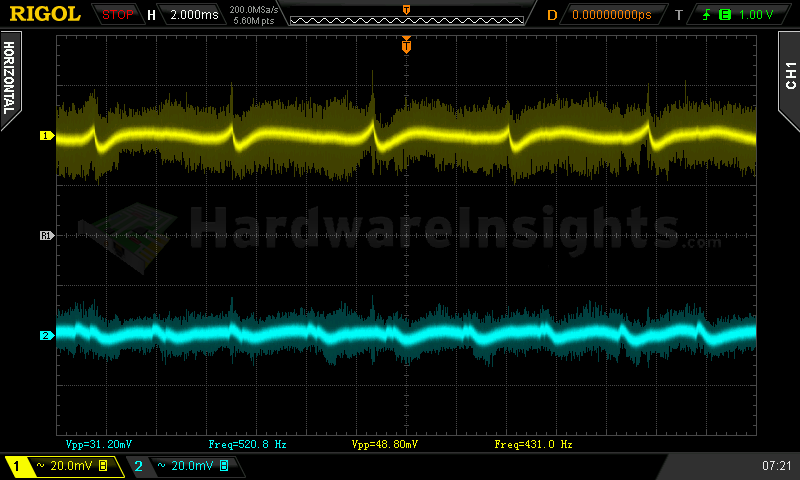Contents
- 1Introducing the Enermax MaxPro 600 W (EMP600AGT)
- 1.1Packaging and accessories
- 2Connectors & cabling
- 2.1Casing & cooling
- 3Input filtering
- 4Primary side
- 4.1+5 V stand-by rail
- 5Secondary side
- 5.1Build quality
- 6Load testing
- 6.1Loading +5 V SB
- 6.2Hold-up time
- 6.3Combined loading
- 6.4Combined loading ripple
- 6.5Crossloading, overloading
- 6.6Crossloading, overloading ripple
- 6.7Fan speed, temperatures and noise
- 7Conclusion and evaluation
- 7.1Thanks
- 7.2Discussion
Load testing
Loading +5 V SB
As always, all load testing is done according to our testing methodology. The efficiency of this units stand-by supply is lower as could be expected from a cheaper unit. Though about 73 % is still a nice result. Also the ripple is higher at around 10 mV. But notice that the voltage regulation is good. The unit starts at 5.10 V (2% difference) and even under overload conditions it still keeps running at 5.00 V. Compared to some high-end units having values like 5.16 V or 4.90 V, this is great.
| Output (W) | Load (A) | Voltage (V)/ ripple (mV) | Input (W) | Efficiency/power factor |
| 0 | 0 | 5.10/9.200 | 0 | —/0.000 |
| 12.24 | 2.43 | 5.03/10.20 | 16.64 | 73.6 %/0.500 |
| 17.07 | 3.41 | 5.00/10.23 | 23.59 | 72.4 %/0.537 |
+5 V SB ripple (left to right): 0 A; 2.43 A; 3.41 A
Hold-up time
As we can see on the oscilloscope screenshot, the hold-up time of the EMP600AGT +12 V rail is quite short, just 10.50 ms. This barely makes it to my absolute minimum. Also notice how rippled it is even on this “zoomed-out” scale (5 ms and 500 mV/div).
The hold-up time of the power good signal is even shorter at just 8.700 ms. At least it’s shorter than the voltage hold-up time as it should be, but man, this is a tragedy. Clearly this unit FAILS to meet ATX specification, big time.
And that’s not all, when interrupting the AC input for a given time, I found that the voltage of the +12 V rail drops further. So to keep in spec (minimum 11.40 V at all times), I had to further decrease the time to 7.760 ms. That is not even half the minimum time dictated by the ATX specification.
Combined loading
Combined loading was mostly OK for the EMP600AGT. Firstly, let’s talk about the voltage regulation. As this is an ordinary group design platform, the results are expected to be mediocre. The +3.3V rail voltage started quite high, at 3.43 V. That is almost 4 % over nominal, not that great of a result. But everything stayed in spec so that is good. You can notice quite OK voltage on the −12 V rail. Considering this is quite an inexpensive platform, that is a good result. Remember how the much more expensive Silverstone Strider Titanium 600 W struggled here last time…
| Output power | Load/ voltage +5 V SB | Load/ voltage +3.3 V | Load/ voltage +5 V | Load/ voltage +12 V | Load/ voltage −12 V | Input power | Efficiency/ power factor |
| 4.7 %/ 27.98 W | 0 A/ 5.05 V | 0.020 A/ 3.43 V | 0.341 A/ 5.16 V | 1.880 A/ 12.09 V | 0.296 A/ −11.56 V | 42.06 W | 66.5 %/ 0.521 |
| 20 %/ 120.37 W | 0.534 A/ 5.03 V | 3.09 A/ 3.43 V | 3.42 A/ 5.11 V | 7.07 A/ 12.18 V | 0.297 A/ −11.77 V | 146.0 W | 82.5 %/ 0.950 |
| 40 %/ 233.93 W | 1.01 A/ 4.99 V | 5.92 A/ 3.40 V | 5.60 A/ 5.07 V | 14.54 A/ 12.16 V | 0.300 A/ −11.89 V | 278.9 W | 83.9 %/ 0.990 |
| 60 %/ 364.44 W | 1.50 A/ 4.95 V | 7.12 A/ 3.33 V | 7.61 A/ 5.04 V | 24.1 A/ 12.09 V | 0.297 A/ −12.01 V | 438.7 W | 83.1 %/ 0.992 |
|
80 %/ 466.44 |
1.85 A/ 4.93 V | 8.89 A/ 3.28 V | 8.99 A/ 5.02 V | 31.5 A/ 12.05 V | 0.292 A/ −12.11 V | 570.2 W | 81.8 %/ 0.993 |
| 100 %/ 604.56 W | 2.33 A/ 4.90 V | 10.16 A/ 3.28 V | 10.12 A/ 5.01 V | 42.3 A/ 11.95 V | 0.299 A/ −12.21 V | 758.5 W | 79.7 %/ 0.994 |
The efficiency is mostly OK. As usual, my instruments measure 3 percentage points lower compared to high-end DC measuring stations. So the maximum may really be around 86 % for this model. It definitely passes on the 80 PLUS EU certification.
Combined loading ripple
The ripple values of the EMP600AGT are terrible. In over half of the measurements the ripple is out of spec, sometimes being over the limit by as much as double. Notice that it first increases and after 50% load it decreases, in a few cases to quite nice values at the end.
| Output % | Ripple +5 V SB | Ripple +3.3 V | Ripple +5 V | Ripple +12 V | Ripple −12 V |
| 4.7 | 70.00 mV | 86.00 mV | 64.00 mV | 104.0 mV | 124.0 mV |
| 20 | 108.0 mV | 108.0 mV | 100.0 mV | 172.0 mV | 106.0 mV |
| 40 | 112.0 mV | 90.00 mV | 114.0 mV | 124.0 mV | 158.0 mV |
| 60 | 54.40 mV | 68.00 mV | 39.20 mV | 94.00 mV | 136.0 mV |
| 80 | 45.60 mV | 66.40 mV | 36.80 mV | 82.40 mV | 80.80 mV |
| 100 | 44.00 mV | 36.00 mV | 24.40 mV | 40.80 mV | 48.80 mV |
Ripple 4.7% load (left to right): +5 V SB; +3.3 V; +5 V; −12 V. The second channel is connected to +12 V.
Ripple 100% load (left to right): +5 V SB; +3.3 V; +5 V; −12 V. The second channel is connected to +12 V.
Crossloading, overloading
Crossloading tests did not go well. Crossloading of both the +3.3 and +12 V rails went good, but the +5 V rail was a different story. The voltage on +12 V rose up to 12.88 at that time. I even tried applying an almost further 4 A to that rail, which amounts to over 75 W, yet the voltage was still at approx. 12.8 V. This is far too much, and so this is the third reason why this unit got its failed status. As for the protections, OCP on +3.3 or +5 V rails did not react to my maximum load I am capable of applying. The +12V OCP turned the EMP600AGT off after stepping up to over 49 A.
| Output power | Load/ voltage +5 V SB | Load/ voltage +3.3 V | Load/ voltage +5 V | Load/ voltage +12 V | Load/ voltage −12 V | Input power | Efficiency/ power factor |
| 17 %/ 104.71 W | 0.527 A/ 5.00 V | 19.94 A/ 3.40 V | 1.537 A/ 5.09 V | 1.887 A/ 12.21 V | 0.291 A/ −11.72 V | 147.9 W | 70.8 %/ 0.957 |
| 23 %/ 132.07 W | 0.529 A/ 5.01 V | 1.488 A/ 3.35 | 19.74 A/ 4.80 V | 2.018 A/ 12.88 V | 0.299 A/ −12.36 V | 174.1 W | 75.9 %/ 0.976 |
| 89 %/ 534.75 W | 0.535 A/ 4.97 V | 1.468 A/ 3.29 V | 1.562 A/ 5.20 V | 44.8 A/ 11.51 V | 0.296 A/ −11.78 V | 662.9 W | 80.7 %/ 0.994 |
| 113 %/ 675.85 W | 3.23 A/ 4.85 V | 10.36 A/ 3.26 V | 11.93 A/ 4.97 V | 47.2 A/ 11.94 V | 0.288 A/ −12.32 V | 868.0 W | 77.9 %/ 0.994 |
The combined limit for OPP is slightly lower as CWT doesn’t usually allow too great of an overload for these cheaper platforms. The maximum was about 675 W. The EMP600AGT remained nicely within spec, but the efficiency dropped to under 80 %.
Crossloading, overloading ripple
The ripple is still bad with lighter loads, but it does improve afterwards.
| Output % | Ripple +5 V SB | Ripple +3.3 V | Ripple +5 V | Ripple +12 V | Ripple −12 V |
| 17 | 90.00 mV | 92.00 mV | 72.00 mV | 106.0 mV | 118.0 mV |
| 23 | 68.00 mV | 98.00 mV | 56.00 mV | 106.0 mV | 114.0 mV |
| 89 | 28.80 mV | 14.80 mV | 20.00 mV | 35.20 mV | 29.60 mV |
| 113 | — | — | 31.60 mV | 37.60 mV | — |
Fan speed, temperatures and noise
The fan inside the Enermax EMP600AGT started spinning right away as soon as the unit was powered on. In the first three tests, it was running just at about 780 RPM. Then the speed increased to approximately 1000 RPM, 1250 RPM and then all the way to the maximum of 1800 RPM. Under 800 RPM it is almost inaudible, at 1000 RPM you already start to hear the fan in a silent room. At 1250 it becomes noticeably noisy and at full speed it’s really loud.
| Output % | Fan speed (RPM) | Temperature intake/ outtake | Noise (dBA) |
| 4.7 | 780 | 27 °C/ 30 °C | 39.4 |
| 20 | 784 | 27 °C/ 31 °C | 39.4 |
| 40 | 780 | 27 °C/ 35 °C | 39.4 |
| 60 | 983 | 29 °C/ 41 °C | 39.5 |
| 80 | 1246 | 30 °C/ 45 °C | 40.1 |
| 100 | 1815 | 31 °C/ 49 °C | 45.4 |
| CL 17 | 782 | 28 °C/ 37 °C | 39.4 |
| CL 23 | 771 | 28 °C/ 39 °C | 39.4 |
| CL 89 | 1765 | 30 °C/ 45 °C | 45.4 |
| OL 113 | 1798 | 31 °C/ 50 °C | 45.4 |
Even then, because of the lower efficiency, the temperatures easily hit 50 °C at full load. With those capacitors, it’s not really a good idea to run the unit so hot. But I would not suggest using this unit at all because of the results of the previous tests anyway. That is also the reason why I skipped the sweater test. I estimate that the unit would indeed handle 15 minutes in a sweater, as CWT does test their units inside a “hot box”. But the temperatures would get very high, I think up to the point when the unit would start smelling badly. The good thing is the advertised HeatGuard systems works and cools the unit for a while after shutting it down.
